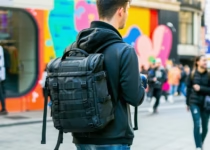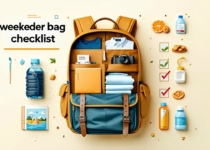Optimizing Carry-On Compliance In Weekender Backpack Design

When we plan a quick weekend escape, nothing slows us down like fumbling over a bag that’s just a tad too big or too heavy. That’s why honing our carry-on weekender design is a total game changer. In this guide, we’ll walk through how we optimize every detail—size, weight, compartments, materials—to sail smoothly through airline checks and into the overhead bin without sacrificing style or storage.
Understanding Carry-On Regulations
Travel rules vary by carrier, but most major US airlines cap roll-on luggage around 22 x 14 x 9 inches. Who wants to pay extra bag fees or gate-check at the last minute? By building our weekender around standard cabin limits, we help you breeze past the check-in line.
Check Airline Size Limits
- Verify the strictest dimensions for your usual carriers
- Factor in wheels and handles, since they count toward exterior size
- Keep measurements under by at least 0.5 inch to avoid surprises
Know TSA Guidelines
We design pockets for easy security screening, so you won’t have to fish out liquids or electronics. For a deeper dive on compliance tweaks, check our TSA-compliant weekender backpack (/tsa-weekender-backpack).
Choosing Optimal Dimensions
Getting dimensions right is half the battle. We balance a slim profile with just enough girth to hold essentials without bulging past cabin rules.
Exterior Measurements
We target about 21.5 x 13.5 x 8.5 inches, which fits most overhead bins. That small buffer keeps us within the 22 x 14 x 9 window while allowing for slight material stretch.
Expandable Panels
Expandable sections add 2–3 liters of capacity when needed, then zip back down for strict size checks. For more on these clever stretch zones, explore our expandable weekender backpack (/expandable-weekender-backpack).
Interior Volume
We aim for roughly 30–35 liters—enough for clothes, electronics, and toiletries. If you want a deeper dive into space planning, see our weekender backpack volume guide (/weekender-backpack-volume).
Balancing Capacity And Weight
An empty bag weighs something, so we pick the lightest materials that still hold up to travel wear. That way you can pack more without tipping the scales.
Lightweight Fabrics
By choosing ultralight nylon or ripstop polyester, we shave off ounces. Looking for minimal carry weight? Check our lightweight weekender backpack roundup (/lightweight-weekender-backpack).
Weight Distribution
We position heavy items close to your back and use side pockets for water bottles or chargers. This keeps the center of gravity stable and reduces shoulder strain.
Packing Aids
Small organizers like packing cubes keep clothes compressed and ordered. We recommend integrating slim pouches so every inch inside your bag works hard—and nothing rattles around. Learn more about cubed packing in our packing cubes in backpack guide (/packing-cubes-in-backpack).
Integrating Smart Compartments
A well-partitioned interior feels like having your own personal valet. We map out each pocket for specific gear so you never rummage in the dark.
Clamshell Opening
A full-zip clamshell design lets you see the entire main compartment at once. It beats top-loading bags for quick grabs and neat folding. See examples in our clamshell weekender backpack feature (/clamshell-weekender-backpack).
Padded Pockets
Dedicated sleeves protect your laptop, tablet, or camera. We line them with soft foam so bumps at the gate don’t translate into cracked screens.
Shoe Compartment
A separate, ventilated shoe pocket keeps dirt away from clothes. It’s a small addition that makes a big difference in organization. See our shoe compartment weekender options (/shoe-compartment-weekender).
Accessory Slots
Elastic loops and mesh pouches hold chargers, headphones, and cables in place. No more digging for that elusive USB cable mid-flight.
Selecting Durable Materials
We aim for fabrics and hardware that survive the rigors of travel day after day. Tear-resistance and water-rejection are must-haves.
Water-Resistant Fabrics
Coated nylon or TPU liners shed moisture on rainy commutes. If splash resistance tops your list, check our waterproof weekender backpack review (/waterproof-weekender-backpack).
Eco-Friendly Options
For the planet-minded, recycled PET or organic cotton blends offer sustainability without compromising toughness. Explore green choices in our eco-friendly weekender backpack guide (/eco-friendly-weekender-backpack).
Fabric Comparison
| Material | Pros | Cons |
|---|---|---|
| Nylon | Lightweight, tear-resistant | Can fade in sun |
| Leather | Stylish, ages well | Heavier, needs conditioning |
| Canvas | Breathable, sturdy | Less water-resistant |
For a deeper comparison, see our canvas vs leather vs nylon backpack breakdown (/canvas-vs-leather-vs-nylon-backpack).
Enhancing Comfort And Fit
A bag that aches your back defeats its own purpose. We fine-tune straps, padding, and fit so you can carry heavier loads with ease.
Adjustable Straps
Length-adjustable shoulder straps let us dial in the ideal torso angle. We add quick-release clips so you can loosen up on the go. Check strap tech in weekender backpacks (/weekender-backpack-straps).
Sternum And Hip Straps
A sternum strap prevents shoulder splay, while a removable hip belt transfers weight to your hips. For more on load-bearing options, view our sternum strap backpack guide (/sternum-strap-backpack).
Back Padding
Mesh back panels boost airflow when you’re hustling through terminals. The foam layout also cradles your spine, cutting down on sweat and soreness.
Prioritizing Security Features
We build in deterrents to keep pickpockets and opportunistic thieves at bay, so you can focus on your trip, not your stuff.
Lockable Zippers
Metal sliders accept tiny TSA-approved locks. We place zipper tracks in hidden seams, making it tough for casual tampering.
Hidden Pockets
Under-flap compartments and false bottoms safeguard passports, wallets, and keys. For more concealment ideas, see our hidden pocket backpack tips (/hidden-pocket-backpack).
RFID Protection
We line select pockets with RFID-blocking fabric to shield credit cards and passports from electronic skimming.
Optimizing Tech And Accessories
Staying powered and connected is crucial on a weekend away. We integrate ports, pockets, and channels for cords so you’re ready to roll.
Built-In Charger
A dedicated compartment holds a power bank outside the main pocket, with an external USB port for on-the-fly charging. Check our weekender backpack charger recommendations (/weekender-backpack-charger) or explore USB-enabled models (/usb-weekender-backpack).
Laptop Sleeve
We include a padded laptop compartment sized for up to a 15-inch device. Some designs even feature a quick-drop pocket that lets you slide through security in seconds.
Detachable Pouches
Clip-in pouches let us stash cables, pens, or earphones neatly, then remove them for desk use without unpacking the entire bag.
Maintaining Backpack Longevity
A well-designed weekender should last years, not seasons. We outline simple habits to keep yours in tip-top shape.
Cleaning And Care
Spot clean with mild soap and water. For deeper cleans, follow fabric-specific instructions in our cleaning weekender backpack guide (/cleaning-weekender-backpack).
Proper Storage
Store your empty bag loosely packed in a cool, dry spot to preserve shape. Avoid folding for months—see our store weekender backpack tips (/store-weekender-backpack).
Frequently Asked Questions
-
What Is the Ideal Carry-On Weekender Size?
Aim for around 21.5 x 13.5 x 8.5 inches externally to fit most overhead bins. -
Can I Expand My Bag and Still Board?
Yes, but keep the expandable section zipped down if you’re close to the limit. -
How Much Weight Can I Carry?
Airlines rarely list weight caps, but most travelers stay under 15–20 pounds for comfort. -
Are Water-Resistant Fabrics Worth It?
Definitely. They protect gear from rain and accidental spills. -
Do I Need a Clamshell Design?
Clamshell openings make packing and unpacking far easier, especially in tight spaces. -
How Do I Keep My Bag From Smelling?
Air it out after trips, use moisture absorbers, and clean spills promptly. -
Can I Charge Devices Without Opening the Bag?
With an integrated USB port or built-in charger pocket, yes—you can top up on the move. -
What Materials Hold Up Best to Frequent Travel?
Ripstop nylon and coated polyesters blend light weight with high durability.
Conclusion
By zeroing in on size, weight, compartments, materials, and comfort, we craft weekender backpacks that slide through cabin checks every time. Give these design tips a try on your next trip, and watch packing stress fade away.
Have a favorite carry-on hack or a question about features we didn’t cover? Drop it in the comments so we can all travel smarter together.


